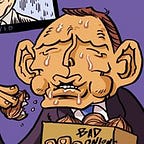Making a “creative” organisation
“Creative” is a loaded word. Everyone’s idea of what it means is different. I don’t even like to use the word most of the time, because it’s usually used to divide us into “creative people” and “non-creative people”.
Because you asked, here’s what I think creativity isn’t:
It’s not a finite resource
I often hear some version of this:
It indicates a couple of different things depending on how it’s being said. Sometimes it feels sad, wistful:
Sometimes it feels dismissive and resentful:
Thinking of creativity as a “thing” you can never have isn’t helpful, but thinking of it as something you can purchase isn’t much better.
It’s not magic
Of course I love clients thinking that what I do is some form of mystical alchemy, because I can then — theoretically — be paid exorbitant amounts for my wizardry.
But it isn’t, really. Here’s the recipe, so you can make it yourself:
In other words, you get excellent at something by having some inborn skills, employing them in a medium or industry you find meaningful and loving it enough to want to spend all your waking hours doing it.
You know that saying “If you love the work you do, you’ll never work a day in your life?” It’s bullshit.
If you love the work you do, you’ll work harder than anyone else because you take pride in it. You’ll think about it outside of traditional work hours. You’ll take all sorts of workplace abuse, including working for nothing. This can lead to premature burnout.
It’s not art
People often conflate “creativity” with “art”. That thinking’s goofy. Some analysts are enormously creative. Some artists produce uninspired handcrafts or seascapes or movie scripts by rote. Is that creative?
“Creative” to me means elastic thinking. An aptitude for making connections others don’t. If people in “creative” roles are capable of that, it’s because they have restless, curious brains, not because they have art skills.
It’s not something you can do from a standing start
When you do decide, “Now I’m going to be creative” — and you should — try not to be too pleased with the first ideas you come up with.
You know when they say “The first instinct is often best”? This assumes your instincts are honed sharp with constant use.
If you’re trying to be creative from a standing start, your first ideas will probably be super boring and obvious. Get past them.
You need time, and you need soup.
Your head is full of brain-soup. All your thoughts are ingredients in the soup. You get more interesting ingredients by having new experiences and meeting different kinds of people.
You need to give these ingredients time to simmer. The longer they’re in there, the better the chance a couple of them will bump into each other and cause something new (and delicious?) to happen.
Getting hung up on your “first best idea” and harping on it forever stunts your creativity.
It’s not easy to advocate for it
Creativity is something businesses say they want a lot of, but society, let alone the workplace, isn’t set up to foster it. Too much speed. Too much stress. Too many distractions.
It’s also difficult to quantify and measure creativity, and things that can’t be measured are easy to argue against, unless the enterprising advocate has hard data or serious political nous.
In the UX Australia talk I did with Luke Watson in 2017, we advocated strongly for diversity in an organisation. I think that’s probably the beginning of any push for “creativity” / “innovation” / “fill in the blank”.
Six steps to creativity
- Assume you have plenty of it already; it just needs to be uncovered.
- Uncover it by allowing yourself and others to combine their natural talents and personal interests.
- Learn to recognise creative thinking, regardless the area a person works in.
- Give yourselves time to warm up into a creative state. This might mean quiet time to think. Work it into your scheduling.
- Don’t beat yourself up when your first ideas aren’t good enough — and beware of your own bias when you decide your first idea is brilliant.
- When you’re looking for creative solutions, let different kinds of thinkers in on the problem.
